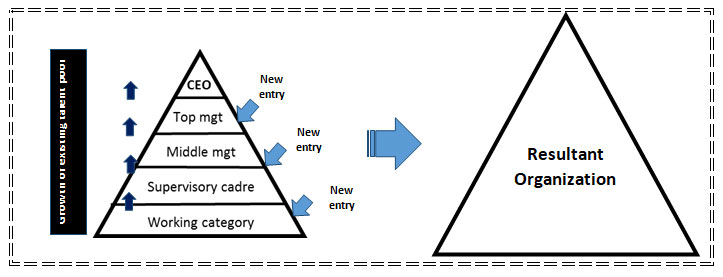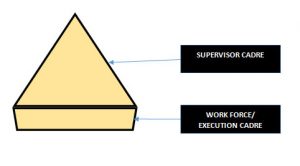Hitachi Strengthening its Analytical Business to Solve Social…

Demographic dividend in India and Pyramidal organization structure | Engineering Review
In this article, I am trying to dwell on seemingly unrelated topics. But my experience in industry in last few years makes me feel it can be a serious concern in a very near future (if not properly addressed).
Demographic dividend:
As per the definition of United Nations population fund (UNFPA), the demographic dividend means, “the economic growth potential that can result from shifts in a population’s age structure, mainly when the share of the working-age population (15 to 64) is larger than the non-working-age share of the population (14 and younger and 65 and older)”.
If you stroll through any national or international magazine of last 5 years, one of the reason for Indian economic revival is strongly attributed to significant demographic dividend.
That means major proportion of our population are in a contributory role rather than being more of a consumer.
So far it is simple to understand, not much of complexity, more people work, better will be the economy.
But this is where my fear starts. The massive demographic dividend we have can become a nightmare if it is not properly managed. And unfortunately there are already few signs to indicate that in our economy.
Many of the Industry wizards have expressed concern on “employability” of new pass outs. But I will keep discussion on that for some other time.
In this article, I am expressing concern because of our pyramidal organization structure.
What is Pyramidal organization structure?
Any organization structure we study, there is lot of work force at the bottom (execution level) and it tapers as we move along the hierarchical ladder.
This evolution is mostly through the entry of new talent into the organization and also growth of existing talent pool within the organization. (of course there are cases where organization grows without manpower expansion—technology substitutes MAN)

Demographic dividend and Pyramidal organization structure:
 Now I will come to the apprehension that I am carrying because of this situation. We are quite aware of the fact that education has taken quite a thrust in last 25-30 years and there is significant improvement in school enrolment. This is a positive development. On the flip side, every student dreams of becoming a doctor, a lawyer, scientist or if not anything else, at least become an engineer. It won’t be an exaggeration if number of engineers would be more than sum total of all other professionals being produced currently.
Now I will come to the apprehension that I am carrying because of this situation. We are quite aware of the fact that education has taken quite a thrust in last 25-30 years and there is significant improvement in school enrolment. This is a positive development. On the flip side, every student dreams of becoming a doctor, a lawyer, scientist or if not anything else, at least become an engineer. It won’t be an exaggeration if number of engineers would be more than sum total of all other professionals being produced currently.
So, there will be significant proportion of workforce in supervisory cadre. But there would be a serious shortage @ the execution level/ on the shop floor.
Most of the candidates of our generation has neither skill set to work on the ground nor we are mentally prepared to pick up the skill set. So, there is absolute dearth of work force to work on the ground.
Due to this, the new structure would look something like the one described below with time.
Because of replacement of human labour with automation, this model may be sustainable for a short duration of time. But this off shape pyramid is not going to be sustainable in a longer run.
Why the off shaped pyramidal model is not sustainable?
- Lower output levels due to unavailability of trained manpower
- Lack of motivation among existing work force as they become minority in organization structure
- Dependency on few skilled workers for critical work (so un even balance of power)
- Most important of all these, very difficult to expand the pyramid without increasing base of it (which is work force)
Probable solutions:
- Have very strong focus on job oriented courses. Incentive these courses to generate sufficient work force. “Skill India” program of the current government is very much in the right direction. We should make it a successful one
- Cultivate a culture of “respect to all skills” in our education system
- Develop a robust ecosystem for entrepreneurship. Hierarchical system is not very rigid in a nimble start up. So, the kind of imbalance in pyramidal set up of larger organizations is not prevalent in smaller and flatter organizations
I am sure there will several ways to address this potential concern. But we need to start acting now.









